Basu P. Biomass Gasification and Pyrolysis: Practical Design and Theory
Подождите немного. Документ загружается.


177
6.3 Fluidized-Bed Gasifiers
Crossdraft gasifiers can be very light and small (<10 kWe). Since layers of
fuel and ash insulate the walls from the high-temperature zone, the gasifier
vessel can be constructed of ordinary steel with refractory linings on the nozzle
and gas exit zone.
The crossdraft design is less suitable for high-ash or high-tar fuels, but it
can handle high-moisture fuels if the top is open so that the moisture can escape.
Particle size should be controlled, as unscreened fuel runs the risk of bridging
and channeling. Crossdraft gasifiers work better with charcoal or pyrolyzed
fuels. For unpyrolyzed fuels, the height of the air nozzle above the grate
becomes critical (Reed and Das, 1988, p. 32).
6.3 FluIdIzed-Bed GasIFIers
Fluidized-bed gasifiers are noted for their excellent mixing and temperature
uniformity. A fluidized bed is made of granular solids, called bed materials,
that are kept in a semi-suspended condition (fluidized state) by the passage
of the gasifying medium through them at the appropriate velocities. The excel-
lent gas–solid mixing and the large thermal inertia of the bed make this type
of gasifier relatively insensitive to the fuel’s quality (Basu, 2006). Along
with this, the temperature uniformity greatly reduces the risk of fuel
agglomeration.
The fluidized-bed design has proved to be particularly advantageous
for gasification of biomass. Its tar production lies between that for updraft
(~50 g/nm
3
) and downdraft gasifiers (~1 g/nm
3
), with an average value of
around 10
g/nm
3
(Milne et al., 1998, p. 14). There are two principal fluidized-
bed types: bubbling and circulating.
6.3.1 Bubbling Fluidized-Bed Gasifier
The bubbling fluidized-bed gasifier, developed by Fritz Winkler in 1921, is
perhaps the oldest commercial application of fluidized beds; it has been in
commercial use for many years for the gasification of coal (Figure 6.8); for
biomass gasification, it is one of the most popular options. A fairly large number
of bubbling fluidized-bed gasifiers of varying designs have been developed and
are in operation (Lim and Alimuddin, 2008; Narváez et al., 1996).
Because they are particularly suitable for medium-size units (<25
MWth),
many biomass gasifiers operate on the bubbling fluidized-bed regime. Depend-
ing on operating conditions, bubbling-bed gasifiers can be grouped as low-
temperature and high-temperature types. They can also operate at atmospheric
or elevated pressures.
In the most common type of fluidized bed, biomass crushed to less than
10
mm is fed into a bed of hot materials. These bed materials are fluidized with
steam, air, or oxygen, or their combination, depending on the choice of
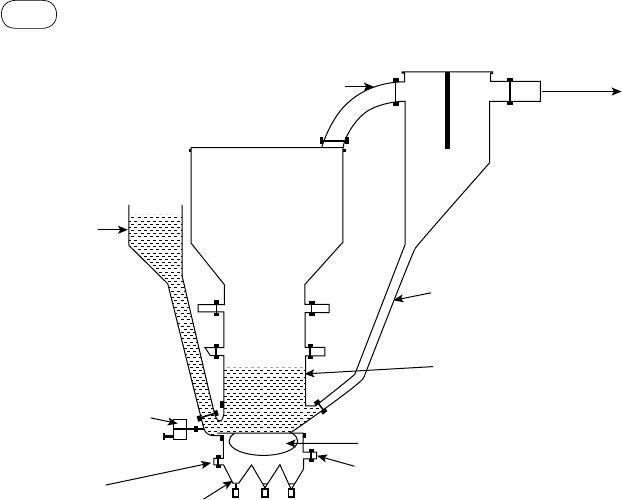
178
chapter
|
6 Design of Biomass Gasifiers
gasification medium. The ash generated from either the fuel or the inorganic
materials associated with it is drained easily from the bottom of the bed. The
bed temperature is normally kept below 980 °C for coal and below 900 °C for
biomass to avoid ash fusion and consequent agglomeration.
The gasifying medium may be supplied in two stages. The first-stage supply
is adequate to maintain the fluidized bed at the desired temperature; the second-
stage supply, added above the bed, converts entrained unreacted char particles
and hydrocarbons into useful gas.
High-temperature Winkler (HTW) gasification is an example of high-
temperature, high-pressure bubbling fluidized-bed gasification for coal and
lignite. Developed by Rheinbraun AG of Germany, the process employs a pres-
surized fluidized bed operating below the ash-melting point. To improve carbon
conversion efficiency, small char particles in the raw gas are separated by a
cyclone and returned to the bottom of the main reactor (Figure 6.9).
The gasifying medium (steam and oxygen) is introduced into the fluidized
bed at different levels as well as above it. The bed is maintained at a pressure
of 10 bars while its temperature is maintained at about 800 °C to avoid
ash fusion. The overbed supply of the gasifying medium raises the local
temperature to about 1000 °C to minimize production of methane and other
hydrocarbons.
The HTW process produces a better-quality gas compared with the gas that
is produced by traditional low-temperature fluidized beds. Though originally
Gas take-off
Gas outlet
Dust separator
Return pipe for
accycling fuel
Gasifier
(5½-ft. deep fluidized bed)
Traveling grate
Air or oxygen tuyere
Ash pit
Steam
Screw feed
Coal
bunker
FIGure 6.8 A sketch of the original Winkler bubbling fluidized-bed gasifier.
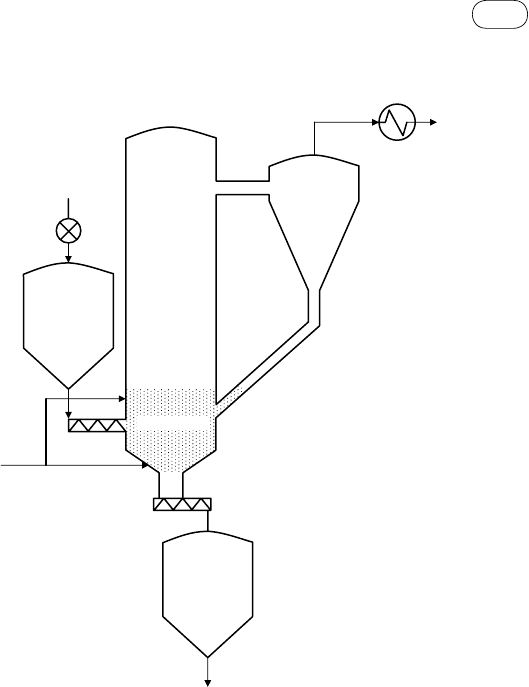
179
6.3 Fluidized-Bed Gasifiers
developed for coal, it is suitable for lignite and other reactive fuels like biomass
and treated municipal solid waste (MSW).
6.3.2 circulating Fluidized-Bed Gasifier
A circulating fluidized-bed (CFB) gasifier has a special appeal for biomass
gasification because of the long gas residence time it provides. It is especially
suitable for fuels with high volatiles. A CFB typically comprises a riser, a
cyclone, and a solid recycle device (Figure 6.10). The riser serves as the gasifier
reactor.
Although the HTW process (Figure 6.9) appears similar to a CFB, it is only
a bubbling bed with limited solid recycle. The circulating and bubbling fluid-
ized beds are significantly different in their hydrodynamic. In a CFB, the solids
are dispersed all over the tall riser, allowing a long residence time for the gas
as well as for the fine particles. The fluidization velocity in a CFB is much
Feed
Lock
hopper
Freeboard
Fluid bed
Cooling screw
Lock
hopper
Air/oxygen/
steam
HTW
gasifier
Syngas
cooler
Feed
screw
FIG
ure
6.9
High-temperature Winkler (HTW) bubbling fluidized-bed gasifier.
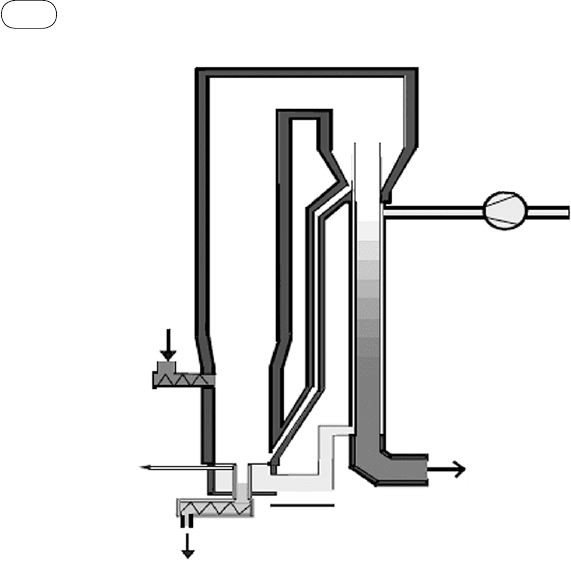
180
chapter
|
6 Design of Biomass Gasifiers
higher (3.5–5.5 m/s) than that in a bubbling bed (0.5–1.0 m/s). Also, there is
large-scale migration of solids out of the CFB riser. These are captured and
continuously returned to the riser’s base. The recycle rate of the solids and the
fluidization velocity in the riser are sufficiently high to maintain the riser in a
special hydrodynamic condition, known as fast fluidized bed. Depending on the
fuel and the application, the riser operates at a temperature of 800 to 1000 °C.
The hot gas from the gasifier passes through a cyclone, which separates
most of the solid particles associated with it, and the loop seal returns the par-
ticles to the bottom of the gasifier. Foster Wheeler developed a CFB gasifier
where an air preheater is located in the standpipe below the cyclone to raise
the temperature of the gasification air and indirectly raise the gasifier tempera-
ture (Figure 6.10).
Many commercial gasifiers of this type have been installed in different
countries. At the time of writing, the biggest among these is a 60-MWth unit
in a coal-fired and natural-gas-fired power plant in Lahti, Finland, to provide a
cheap supplementary fuel by gasifying waste wood and refuse-derived fuels
(RDFs). Several manufacturers around the world have developed versions of
the CFB gasifier that work on the same principle and vary only in engineering
details.
Reactor
850 °C
900 °C
Biofuel feed
Bottom ash-cooling screw
Bottom ash
Product gas at
650–750 °C
Air preheater
Gasification air fan
Uniflow cyclone
Return leg
Cooling
water
FIG
ure
6.10
Circulating fluidized-bed gasifier. (Source: Adapted from Foster Wheeler.)

181
6.3 Fluidized-Bed Gasifiers
Transport Gasifier
This type of gasifier has the characteristics of both entrained-flow and fluidized-
bed reactors. The hydrodynamics of a transport gasifier is similar to that of a
fluid catalytic cracking reactor. A transport gasifier operates at circulation rates,
velocities, and riser densities considerably higher than those of a conventional
circulating fluidized bed. This results in higher throughput, better mixing, and
higher mass and heat-transfer rates. The fuel particles are also very fine (Basu,
2006) and as such it requires a pulverizer or a hammer mill. A comparison of
typical hydrodynamic operating conditions in a transport gasifier and in a fluid
catalytic cracking unit is given in Table 6.3.
A transport gasifier consists of a mixing zone, a riser, a disengager, a
cyclone, a standpipe, and a J-leg. Coal, sorbent (for sulfur capture), and air are
injected into the reactor’s mixing zone. The disengager removes the larger
carried-over particles, and the separated solids return to the mixing section
through the J-valve located at the base of the standpipe (Figure 6.11). Most of
the remaining finer particles are removed by a cyclone located downstream,
from which the gas exits the reactor. The reactor can use either air or oxygen
as the gasification medium.
Use of oxygen as the gasifying medium avoids nitrogen, the diluting agent in
the product gas. For this purpose, air is more suitable for power generation, while
oxygen is more suitable for chemicals production. The transport gasifier has
proved to be effective for gasification of coal, but it is yet to be proven for biomass.
Twin Reactor System
One of the major problems in air gasification of coal or biomass is the dilution
of product gas by the nitrogen in the air used for the exothermic combustion
TABLE 6.3 Comparison of Hydrodynamic Operating Conditions
of Commercial Transport Gasifier and Circulating Fluidized Bed
of Fluid Catalyst Cracking Units
Parameter
Smith et al.,
2002
Peterson and
Werther,
2005
Zhu and
Venderbosch,
2005
Particle size (µm)
200–350 180–230 20–150
Riser velocity (m/s) 12–18 3.5–5.0 6–28
Circulation rate (kg/m
2
⋅s)
730–3400 2.5–9.2* 400–1200
Riser temperature (°C) 910–1010 800–900 500–550
Riser pressure (bar) 140–270
psig 1 bar 150–300
kPa
Reactor KBR gasifier CFB gasifier FCC cracker
*Computed from comparable units.
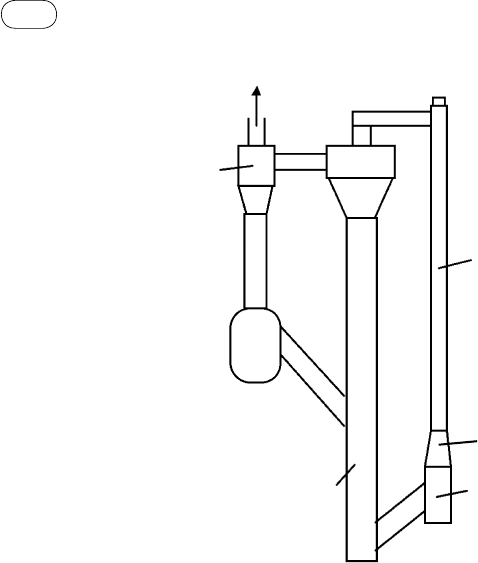
182
chapter
|
6 Design of Biomass Gasifiers
reaction necessary in a self-sustained gasifier. To avoid this, oxygen is used
instead, but oxygen gasification is expensive and highly energy intensive (see
Example 6.5 later in chapter). A twin reactor (e.g., a dual fluidized bed) over-
comes this problem by separating the combustion reactor from the gasification
reactor such that the nitrogen released in the air combustion does not dilute the
product gas. Twin reactor systems are used for coal and biomass. They are
either externally circulating or internally circulating.
This type of system has some limitations; for example, Corella et
al. (2007)
identified two major design issues with the dual fluidized-bed system:
Biomass contains less char than coal contains; however, if this char is used
for gasification the amount of char available may not be sufficient to provide
the required endothermic heat to the gasifier reactor to maintain a tempera-
ture above 900 °C. External heating may be necessary.
Though the gasifier runs on steam, only a small fraction (<10%) of the steam
participates in the gasification reaction; the rest of it simply leaves the gas-
ifier, consuming a large amount of heat and diluting the gas.
The Technical University of Vienna used the externally circulating system
to gasify various types of biomass in an industrial plant in Gussing, Austria.
Riser
Mixing
zone
Standpipe
Cyclone
To syngas cooler
J-valve
FIGure 6.11 A sketch of a typical transport fluidized-bed gasifier.
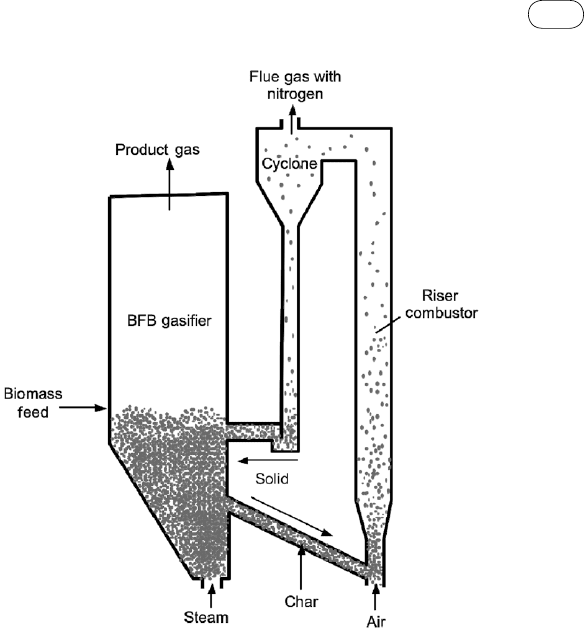
183
6.3 Fluidized-Bed Gasifiers
The system is comprised of a bubbling fluidized-bed gasifier and a circulating
fluidized-bed combustor (Figure 6.12). The riser in a CFB operates as a com-
bustor; the bubbling fluidized bed in the return leg operates as a gasifier.
Pyrolysis and gasification take place in the bubbling fluidized bed, which is
fluidized by superheated steam. Unconverted char and tar move to the riser
through a nonmechanical valve. The riser is fluidized by air.
Tar and gas produced during pyrolysis are combusted in the riser’s combus-
tion zone. Heat generated by combustion raises the temperature of the inert bed
material to around 900 °C. This material leaves the riser and is captured by the
cyclone at the riser exit. The collected solids drop into a standpipe and are then
circulated into the bubbling fluidized-bed reactor to supply heat for its endo-
thermic reactions. The char is gasified in the bubbling bed in the presence of
steam, producing the product gas. This system overcomes the problem of tar
by burning it in the combustor. In this way, a product gas relatively free of tar
can be obtained.
The Rentech-Silvagas process is also based on the externally circulating
principle. Here, both the combustor and the gasifier work on circulating fluid-
ized-bed principles. In the internally circulating design, the fluidized-bed
FIGure 6.12 Twin reactor (dual fluidized-bed) gasifier.
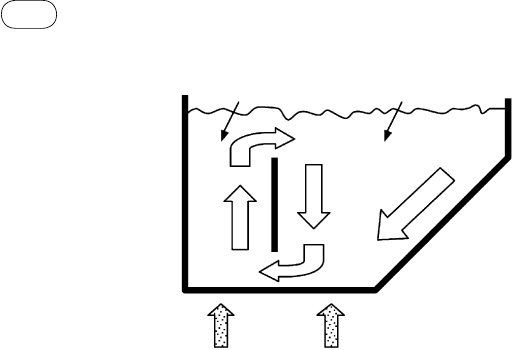
184
chapter
|
6 Design of Biomass Gasifiers
reactor is divided into two chambers and connected by a window at the bottom
of the division wall separating them. The chambers are fluidized at different
velocities (Figure 6.13), which result in their having varying bed densities. As
the bed height is the same in both, the hydrostatic pressure at the bottom of the
two chambers is different. The biomass and sand thus flow from the higher-
density chamber to the lower-density chamber, creating a continuous circulation
of bed materials similar to the natural circulation in a boiler. This helps increase
the residence time of solids in the fluidized bed.
Such an arrangement can provide a more uniform distribution of biomass
particles in the reactor, with increased gasification yield and decreased tar and
fine solids (char) in the syngas (Freda et al., 2008). A special feature of the
twin reactor is that more air or oxygen can be added in one part of the bed
to encourage combustion, and more steam can be added in another part to
encourage gasification.
Chemical Looping Gasifier
Chemical looping is a relatively new concept. Its primary motivation is produc-
tion of two separate streams of gases—a product gas rich in hydrogen and a
gas stream rich in carbon dioxide—such that the CO
2
can be sequestrated while
the hydrogen can be used for applications that require hydrogen-rich gas. The
system uses calcium oxide as a carrier of carbon dioxide between two reactors:
a gasifier (bubbling fluidized bed) and a regenerator (circulating fluidized bed).
The CO
2
produced during gasification is captured by the CaO and released in
a second reactor during sorbent regeneration.
Figure 6.14 is a schematic of the chemical looping process. Biomass is fed
into the gasifier that receives calcium oxide from the regenerator and super-
heated steam from an external source. During gasification, the carbon dioxide
produced is captured by the calcium oxide that makes up the bubbling fluidized
bed (Acharya et
al., 2009), as follows:
Upflowing
chamber
Downflowing
chamber
Fluidizing agents
FIGure 6.13 Internally circulating dual fluidized-bed gasifier.
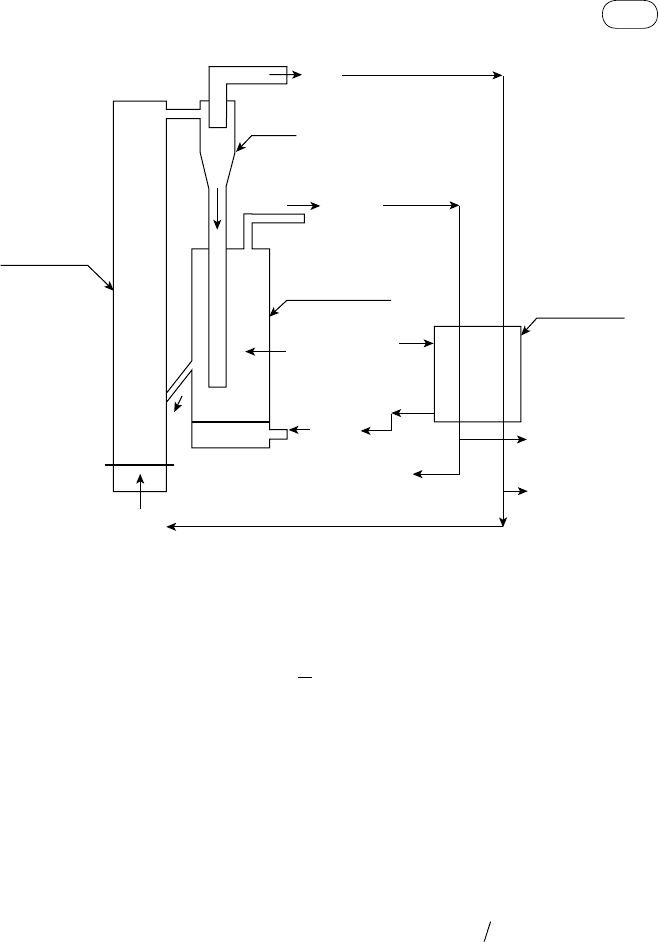
185
6.4 Entrained-Flow Gasifiers
Gasification reaction C H O H O CaO CaCO:
n h o
n p n n
h
n o
+ −
( )
+ ↔
+ + −
2
2
2
2 3
H
2
(6.1)
CO H O CO H+ ↔ +
2 2 2
(6.2)
CO removal reaction CaO CO CaCO
2 2 3
: + → (6.3)
Immediate removal of the reaction product, CO
2
, from the system increases
the rate of forward reaction (Eq. 6.2), enhancing the water–gas shift reaction,
therefore yielding more hydrogen in the product gas. The calcium carbonate
formed in the gasifier (Eq. 6.3) is transferred to a circulating/transport regenera-
tor, where it is calcined into calcium oxide and carbon dioxide.
Regeneration CaCO CaO CO kJ mol
2
: .
3
178 3→ + + (6.4)
The carbon dioxide and the product gas leave the regenerator and gasifier,
respectively, at a high temperature. The hot product can be used for generation
of steam needed for gasification.
6.4 entraIned-Flow GasIFIers
Entrained flow is the most successful and widely used gasifier type for large-
scale gasification of coal, petroleum coke, and refinery residues. It is ideally
CFB/transport
regenerator
Cyclone
CO
2
Bubbling fluidized-
bed gasifier
Water
Steam
CO
2
CaCO
3
CO
2
for
sequestration
External heating
of regenerator
Fuel
Heat
exchanger
Product gas
for application
Product
gas
CaO
FIGure 6.14 Chemical looping gasification with CaO as the carrier of CO
2
between the gasifier
and the regenerator.

186
chapter
|
6 Design of Biomass Gasifiers
suited to most types of coal except low-rank coal, which, like lignite and
biomass, is not attractive because of its large moisture content. High-ash coal
is also less suitable because cold-gas efficiency decreases with increasing ash
content. For slurry-fed coal, the economic limit is 20% ash; for dry feed it is
40% (Higman and Burgt, 2008, p. 122).
The suitability of entrained-flow gasification for biomass is questionable
for a number of reasons. Owing to a short residence time (a few seconds) in
entrained-flow reactors, the fuel needs to be very fine, and grinding fibrous
biomass into such fine particles is difficult. For biomass with CaO but no
alkali, the ash-melting point is high, and therefore it has a higher oxygen
requirement. The melting point of biomass ash with a high alkali content is
much lower than that of coal. This reduces the oxygen required to raise the
temperature of the ash above its melting point. However, molten biomass ash
is highly aggressive, which greatly shortens the life of the gasifier’s refractory
lining.
For these reasons entrained-flow reactors are not preferred for biomass
gasification. Still, they have the advantage of easily destroying tar, which is
very high in biomass and is a major problem in biomass gasification.
Entrained-flow gasifiers are essentially co-current plug-flow reactors, where
gas and fuel travel. The hydrodynamics is similar to that of the well-known
pulverized-coal (PC) boiler, where the coal is ground in a pulverizing mill to
sizes below 75 micron and then conveyed by part of the combustion air to a
set of burners suitably located around the furnace. The reactor geometry of the
entrained-flow gasifier is much different from the furnace geometry of a PC
boiler. Additionally, an entrained-flow gasifier works in a substoichiometric
supply of oxygen, whereas a PC boiler requires excess oxygen.
The gasification temperature of an entrained-flow gasifier generally well
exceeds 1000 °C. This allows production of a gas that is nearly tar-free and has
a very low methane content. A properly designed and operated entrained-flow
gasifier can have a carbon conversion rate close to 100%. The product gas,
being very hot, must be cooled in downstream heat exchangers that produce
the superheated steam required for gasification.
Figure 6.15 describes the working principle of an entrained-flow gasifier by
means of a simplified sketch. The high-velocity jet forms a recirculation zone
near the entry point. Fine fuel particles are rapidly heated by radiative heat from
the hot walls of the reactor chamber and from the hot gases downstream, and
start burning in excess oxygen. The bulk of the fuel is consumed near the
entrance zone through devolatilization; here the temperature may rise to as high
as 2500 °C.
The combustion reaction consumes nearly all of the oxygen feed, so the
residual char undergoes gasification reactions in CO
2
and H
2
O environments
downstream of this zone. These reactions are relatively slow compared to the
devolatilization reaction, so the char takes much longer to complete its conver-
sion to gases. For this reason, a large reactor length is required.
